You’ll achieve excellent pest control with these seven proven neem oil recipes for flower gardens. Mix 2 tablespoons pure neem oil with 1 gallon warm water and 2 teaspoons dish soap for general pests. Use cold-pressed formulas for aphids, high-strength solutions for severe infestations, and soil drenches for root protection. Quick-application sprays work for immediate control, while preventative treatments protect seasonal gardens. Fine mist recipes suit delicate varieties perfectly. These thorough formulations address every flowering plant pest challenge you’ll encounter.
Basic Neem Oil Spray Recipe for General Flower Pests
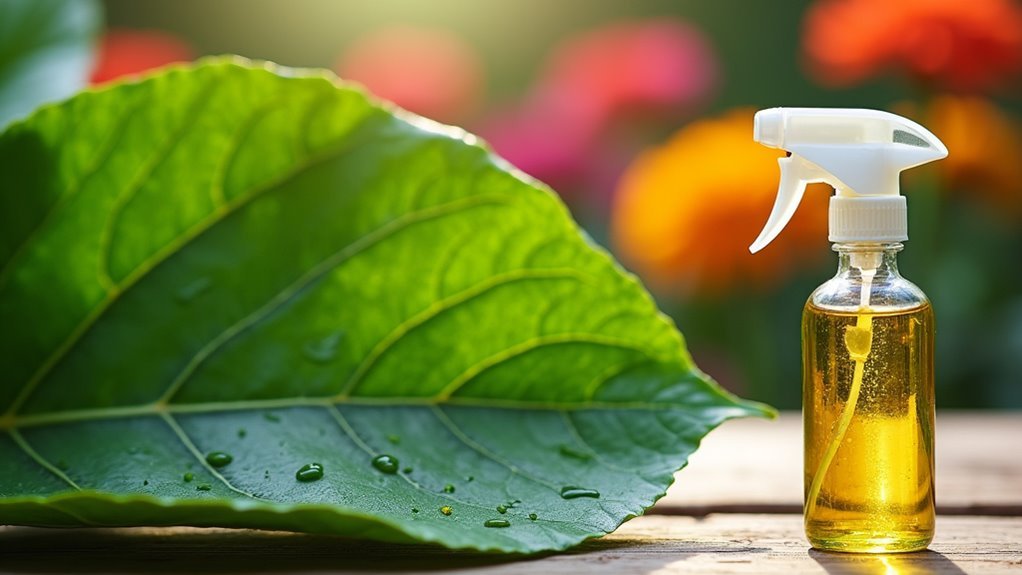
When dealing with common flower pests like aphids, mealybugs, and thrips, you’ll need a simple yet effective neem oil spray that’s easy to prepare at home.
To make neem oil spray, combine 2 tablespoons of 100% pure neem oil with 1 gallon of warm water and 2 teaspoons of gentle dish soap. The warm water helps create a uniform solution while soap acts as an emulsifier.
Mix 2 tablespoons pure neem oil, 1 gallon warm water, and 2 teaspoons gentle dish soap for effective pest control.
Shake well before each application since the oil separates over time. Neem oil works best when applied generously to all plant leaves, including undersides where bugs often hide.
Use this natural pest control method in your garden within 8 hours of mixing for maximum potency and effectiveness.
Cold-Pressed Neem Oil Formula for Aphids and Soft-Bodied Insects
Cold-pressed neem oil delivers superior results against aphids and soft-bodied insects because it retains higher concentrations of azadirachtin, the compound that disrupts pest feeding and reproductive cycles.
You’ll need to mix 1-2 tablespoons of cold-pressed neem oil with one gallon of water, adding one tablespoon of mild liquid soap as an emulsifier for your neem oil spray.
Apply this mixture every 7-14 days, ensuring full coverage of both upper and lower leaf surfaces to eliminate current pests and prevent future infestations.
Always test the spray on a small plant section first to check for adverse reactions.
Prepare small batches since the solution degrades quickly—use within 8 hours for maximum effectiveness against these destructive pests.
High-Strength Neem Oil Solution for Severe Infestations

Severe pest infestations require a more aggressive approach that doubles the concentration of your standard neem oil treatment.
When you’re facing overwhelming pest populations that won’t respond to basic neem sprays, it’s time to escalate your strategy with a high-strength neem oil solution.
For maximum effectiveness against tough infestations, follow these steps:
- Mix 2-4 tablespoons of 100% pure, cold-pressed neem oil per gallon of water with 2-3 tablespoons of mild liquid soap for enhanced emulsification.
- Apply every 3-5 days until the pest population diminishes, ensuring you coat undersides of leaves where pests hide.
- Use only pure neem oil with high azadirachtin concentration for best results.
- Store unused solution in cool, dark conditions and use within 8 hours for maximum potency.
Neem Oil Soil Drench Recipe for Root-Zone Pest Protection
While foliar sprays target visible pests on leaves and stems, soil drenches deliver neem oil’s protective compounds directly to your plant’s root zone where hidden threats like fungus gnats and root-feeding nematodes cause damage.
This neem tree extract works systemically when absorbed through roots, disrupting pest growth while protecting against soil-borne diseases.
Mix 1-2 tablespoons of neem oil with one gallon of warm water, adding one tablespoon of mild liquid soap as an emulsifier. Saturate the soil around your plant’s base thoroughly.
Apply every 3-4 weeks as a preventative measure, or weekly during active infestations. The solution effectively controls root-zone pest protection while remaining gentle on plants.
Store unused neem oil in cool, dark conditions to maintain potency.
Quick-Application Neem Oil Spray for Immediate Pest Control
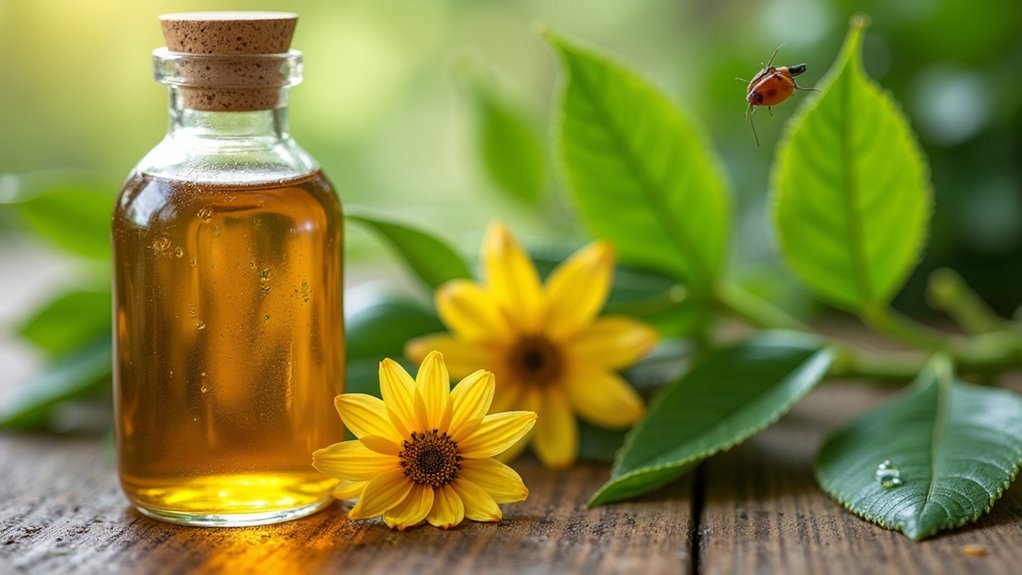
When flower pests launch a sudden attack on your prized blooms, you need a fast-acting solution that delivers immediate results.
This homemade neem oil foliar spray offers low toxicity pest control that’s both effective and easy to use. Mix 1 tablespoon of pure neem oil with 1 tablespoon of mild liquid soap in 1 quart of warm water for proper emulsification.
Follow these steps for maximum effectiveness:
- Shake well before each use to prevent oil separation
- Apply generously to both leaf tops and undersides where pests hide
- Spray during early morning or late evening to avoid sunlight degradation
- Reapply every 7-14 days for persistent infestations
You’ll see noticeable effects on your plant within 2-3 days of application.
Preventative Neem Oil Treatment for Seasonal Flower Gardens
Beyond addressing immediate pest problems, you can stay ahead of potential infestations with a proactive neem oil treatment schedule for your seasonal flower gardens.
Start preventative treatments two weeks before typical pest emergence in your area. Mix 1-2 tablespoons of 100% pure cold-pressed neem oil per gallon of water, adding one tablespoon of mild liquid soap for proper emulsification.
Apply this foliar spray every 7-14 days, thoroughly coating leaf tops and undersides. Always spray during early morning or late evening hours to prevent sunlight from degrading the oil and damaging plants.
Monitor and document pest activity regularly to adjust application frequency and concentration as needed for peak garden protection.
Fine Mist Neem Oil Recipe for Delicate Flower Varieties
When you’re working with delicate flower varieties like petunias, impatiens, or begonias, you’ll need to adjust your neem oil application method to prevent damage to sensitive petals and foliage.
These fragile plants can’t handle the standard spray droplet size that works for hardier flowers, so creating a fine mist becomes essential for effective treatment.
You’ll want to focus on application techniques that deliver thorough coverage while minimizing stress to your most vulnerable blooms.
Delicate Flower Considerations
Delicate flowers require extra care when applying neem oil treatments, as their sensitive petals and leaves can easily suffer damage from standard concentrations.
You’ll need to use a fine mist solution with lower concentration to prevent phytotoxicity while maintaining effective pest control.
Here are essential considerations when treating delicate flowers:
- Conduct a patch test on one leaf 24-48 hours before full application to check for adverse reactions.
- Apply neem oil during early morning or late evening to avoid leaf burn from direct sunlight exposure.
- Use 0.5% concentration maximum – mix 1 teaspoon neem oil with 1 quart water and gentle soap.
- Reapply every 7-14 days or after heavy rainfall to maintain protection without overwhelming sensitive plants.
Always prioritize plant health over aggressive pest treatment schedules.
Fine Mist Application
Since delicate flowers need gentler treatment than hardier garden plants, creating a proper fine mist application guarantees you’ll deliver effective pest control without causing damage. Mix 1 teaspoon cold-pressed neem oil with 1 quart warm water and 0.5 teaspoons mild liquid soap to create your fine mist spray solution.
| Component | Amount | Purpose |
|---|---|---|
| Neem oil | 1 teaspoon | Active pest control ingredient |
| Warm water | 1 quart | Solution base for dilution |
| Mild liquid soap | 0.5 teaspoons | Creates stable emulsion |
Shake thoroughly before each use since oil separates naturally. Apply neem oil during early morning or late afternoon to prevent direct sunlight damage. Use frequent applications every 7-14 days to manage pest populations effectively while minimizing stress to delicate flower varieties.
Frequently Asked Questions
How Do You Mix Neem Oil for Flowers?
You’ll mix 1-2 tablespoons neem oil with one gallon water, adding one tablespoon mild soap as emulsifier. Shake well before applying to guarantee proper mixing, then spray generously on leaf tops and undersides.
What Is the Best Mixture for Neem Oil?
You’ll want to use 1-2 tablespoons of pure neem oil per gallon of water with 1 tablespoon of liquid dish soap. This creates an effective 0.5-1% concentration that won’t burn leaves.
What Not to Mix With Neem Oil?
You shouldn’t mix neem oil with baking soda, synthetic pesticides, mineral oils, eucalyptus oil, or harsh detergents. These combinations can neutralize neem’s effectiveness, cause unpredictable reactions, or damage your plants.
What Flowers Not to Use Neem Oil On?
You shouldn’t use neem oil on orchids, fuchsias, African violets, geraniums, or petunias since they’re sensitive to its compounds. Always test a small area first and avoid spraying flowers in full bloom.
In Summary
You’ve now got seven proven neem oil recipes to tackle any flower pest problem you’ll encounter. Start with the basic spray for everyday issues, then scale up to stronger solutions when needed. Don’t forget preventative treatments work better than reactive ones. Test each recipe on a small area first, and you’ll keep your flowers healthy and pest-free throughout the growing season.

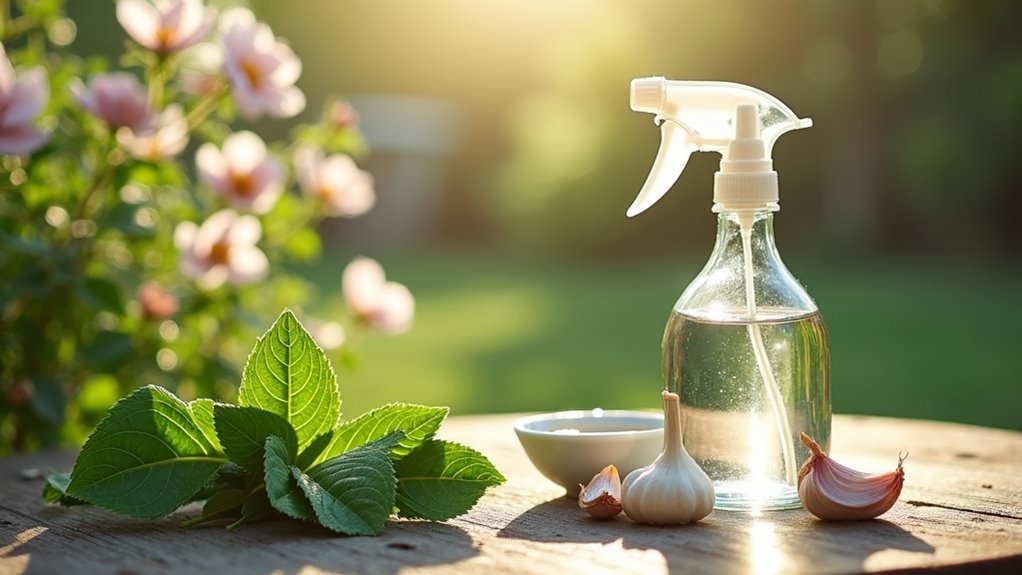
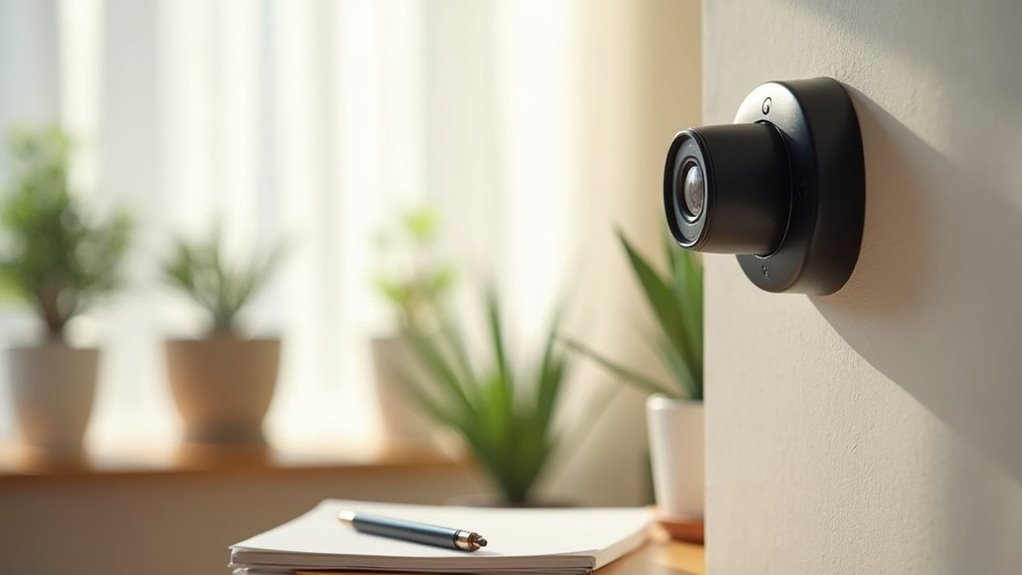

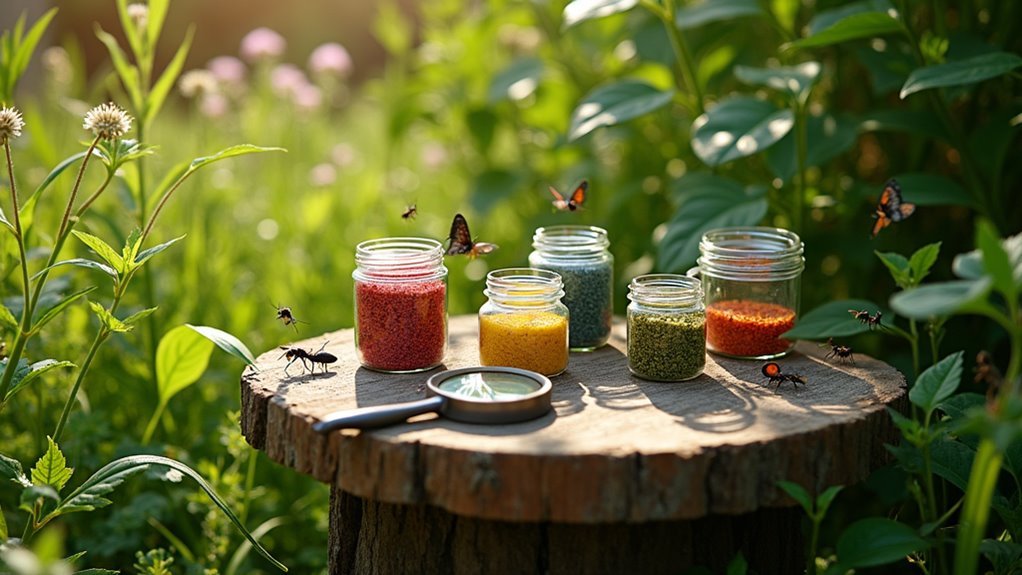
Leave a Reply